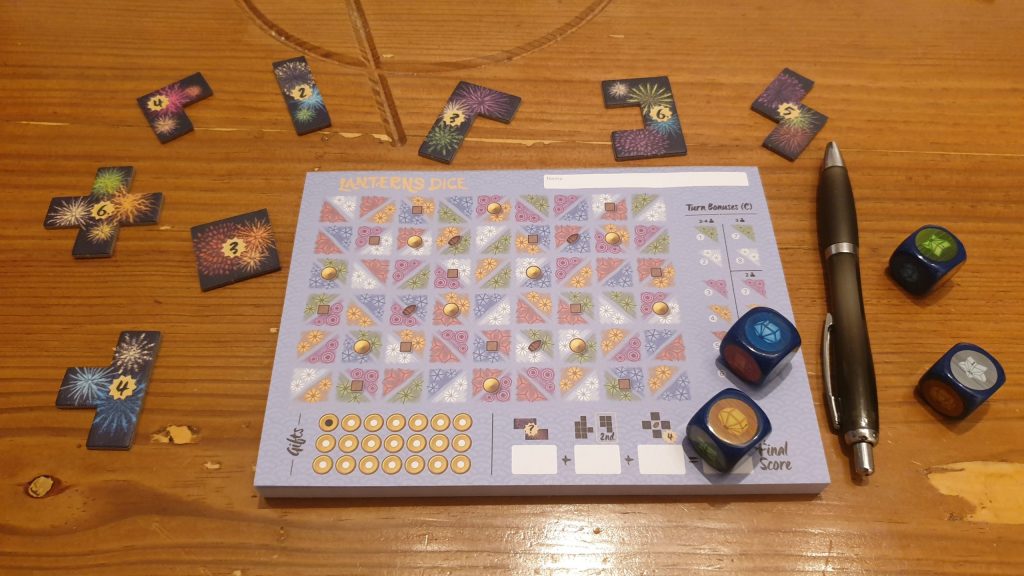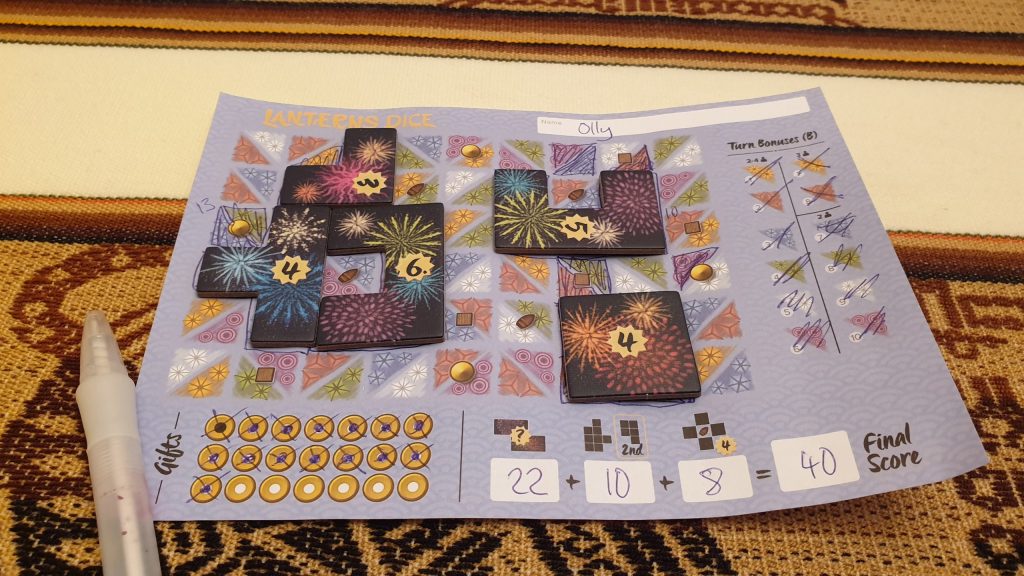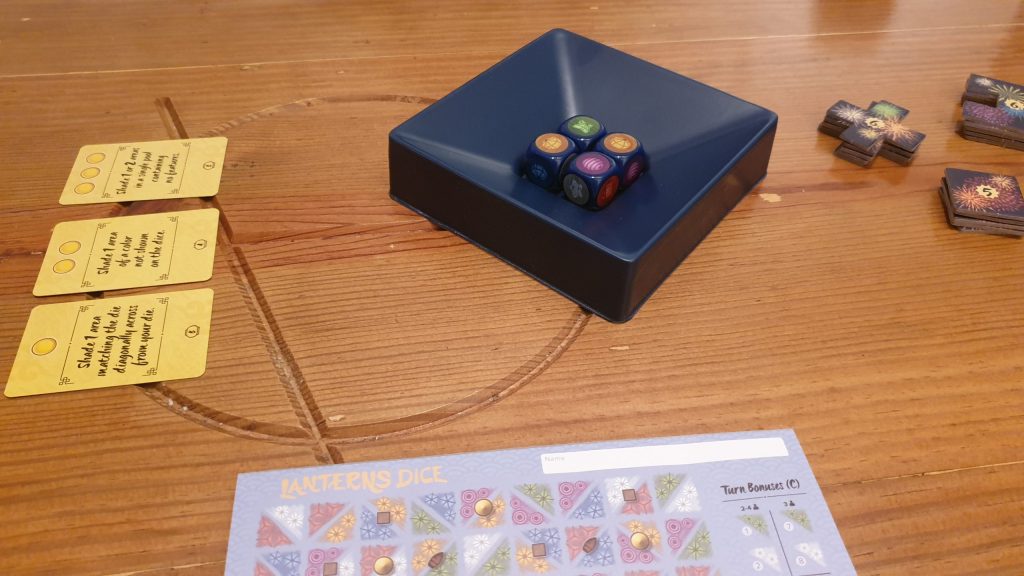Lanterns Dice: Lights in the Sky is the brand new dice based roll and write reimplementation of Lanterns, from Foxtrot Games and Renegade Game Studios. Designed by Chris Bryan, featuring artwork from Jason D. Kingsley, John Shulters and Beth Sobel, the game sees artisans once again launching fireworks in a harvest festival. 2 – 4 players will roll dice, for around 30 – 40 minutes, in an attempt to gain the most honour at the festival. However, does the reimplementation from tiles cause explosive gameplay? Let’s find out!
At the start of the game each player gets a unique scoresheet from the pad. There are 4 unique variants in the pad (labeled A – D), with the round bonus order of colours differing. Out of the 8 firework tile shapes four are selected, the rest being returned to the box. Piles of the choose shapes are then made, with the lower values at the bottom of the piles. While the game suggests four shapes for the first game this makes no impact on the difficulty. The three emperor cards are then placed within sight of all players. These have an A & B side, with A recommended – being slightly quicker to explain for new players. Players will need to grab a pen / pencil before starting. Finally, it is time to put the dice and dice tray in the middle of the table.
Lanterns Dice is one of those games where it expects players to be perfectly sat around a rectangular table, with one player per side. It isn’t a problem if you aren’t but players will have to somewhat pretend they are. Taking it in turns the active player takes the four dice and rolls them into the tray. They then twist the tray around so the one dice is facing each player – hence the ideal sitting situation. The dice facing each player is what they recieve. For example, if the dice facing you has a blue face you will be about to shade in a blue area.
The player sheets are made up of square pools, which are in turn made of two coloured lantern area triangles. From the received colour from the dice players shade in a triangle of that colour. Note, a pool is not classed as complete until both triangles are shaded. Some pools come with special features. Boats are on some pools. These score if not shaded and surrounded by shaded pools – so best to leave them unshaded if possible. Some pools have pavillions on them which if either adjacent triangle is shaded earn the player a coin.

The third potential feature is a platform. Only once both triangles adjacent to it are shaded does its power trigger. This allows the player to instantly shade in one triangle from an adjacent lantern area. This is one of the primary ways to combo shading in areas in Lanterns Dice. At this stage the active player gets a round bonus of a specific colour, which they also get to shade in.
Now is the time to spend coins on emperor abilities, with all players starting with one coin. These powers range from paying 1 coin to shade in a second triangle of the received colour through to receiving the other three dice colours for three coins. Each player, not just the active player, can pay for one of these each round. While basic turns may see only one triangle shaded, this is another way of comboing and building up a bigger individual turn.
The final stage of a turn sees the active player able to launch a firework. Based on regions of completed pools a player can claim the top most firework tile (the most valuable) of a shape. This shape must fit over only shaded in pools. Fireworks cannot overlap so once used in this way the covered and completed pools are blocked from future shapes.
Play then moves onto the next player, with them becoming the active player and starting a new turn with rolling the dice. This continues for a number of rounds, the exact amount dependant on the player count. For example in a 2 player game each player will be the active player 10 times, though there will be 20 turns in total. After this each player gets 1 final turn to launch a firework, important as otherwise those not the active player on the final turn would be unable to launch.

Points are then calculated starting with those denoted on collected firework tiles. Next, players gain a point per completed pools in their second biggest region. This is an interesting one as it’ll mean players don’t necessarily want to link all of their shaded pools together. Finally, four points are earnt per unshaded boat pool that is adjacently surrounded by shaded pools. The winner is the player with the most points. Ties are split by whomever scored the most from fireworks, else the victory is shared.
It may be made up of very different components but Lanterns Dice captures the same feeling as the original. Turns have the same approximate pattern to them, with the same concept of what is facing you being what you’ll receive carried over nicely. With the tiles in the original there was an element of comboing by aligning them perfectly colour-wise. While this method doesn’t quite make the dice version there is still the opportunity for combos.
Both the coin costing abilities and platform bonuses allow for large combos. The best part of both aspects is that they trigger even when it isn’t your active turn. Players aren’t stuck making lacklustre moves, especially if they die pointing towards them is what they need or they have coins to use. Filling the sheet slowly but surely is the aim, so any chance to do more than just a single lantern area feels like real progress has been made.
There are only three methods to get points. These don’t change, nor do they differ in the points they score, from one game to the next. Despite this, there isn’t a clearly defined route to victory. Players must look to improvise with the colours that are rolled. They can mitigate some of the luck via the comboing or coins. Nevertheless, the order that colours come out results in two games never being quite the same. The way the three point scoring methods interact also means there is always a balancing act to be made, with sometimes a single point splitting players.

The player sheets being different is a forgettable aspect of the experience. If a player pays attention to their bonuses order they may pick slightly differently. Still, if in one game blue is the last and in another purple is, the specific colour is the factor not the ordering. It is somewhat of an unnecessary nicety many will not notice. Regardless of this though the pad for the scoresheets is decent, featuring a good amount of colour whilst managing to be clear to read and shade.
The tiles are great to make the launched fireworks pop. Alas, they are easily nudged when shading and are a little awkward to work around. Drawing around the appropriate shape when acquired to reserve the space, using the tile as a points reminders, works well to avoid this. Aside from missing pens, a hurdle a surprising number of roll and writes stumble at, the only component that may have been nice to include would be a first player marker. It isn’t overly needed after a game or two. However, when playing for the first time there were some stages when we had to work out whom had just been the active player – simply due to the amount players can do sometimes when it isn’t their turn.
Lanterns Dice: Lights in the Sky is an engaging roll and write with a strong level of choice interwoven through every turn. The core concepts of the original have been nicely converted, with the dice rolling being a faster way to keep the gameplay flowing. Some of the aspects built into the game for variety and replayability seem a little forced, and don’t actually change things much. Still, due to the way big combo turns can happen, even on other players turns, Lanterns Dice is a game I’d be happy to play regardless of the player count.
(Editor’s Note: Lanterns Dice: Lights in the Sky was provided to us by Asmodee for the review. The game is currently available from local board game stores, find your local store here.)

